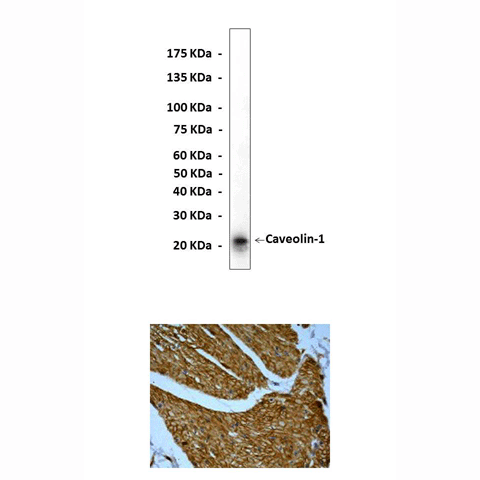Anti-Caveolin-1: Rabbit Caveolin-1 Antibody |
 |
BACKGROUND Caveolin-1 is a member of caveolin family which also includes two other members: Caveolin-2 and Caveolin-3. Caveolin-2 has the same tissue distribution as and co-localizes with Caveolin-1, whereas Caveolin-3 is expressed only in cardiac, skeletal, and smooth muscle cells. Caveolin-1 is the principal structural protein of caveolae membranes in most cell types and acts as a scaffolding protein within caveolar membranes. Caveolae are specialized membrane microdomains formed as a result of localized accumulation of cholesterol, glycosphingolipids, and caveolin. Although caveolae function in vesicular and cholesterol trafficking, they have also been implicated in signal transduction at the plasma membrane. Caveolin-1 is intricately involved in caveolar functioning and has been found to be a key regulator of some of signaling proteins. Many of the proteins that interact with, transcriptionally repress, or are inhibited by Caveolin-1 fall under the pro-proliferative, oncogenic, and anti-apoptotic category of molecules. Caveolin-1 interacts with and negatively regulates the EGFR, PDGFR, and Neu tyrosine kinases, Ha-Ras, c-Src, and phosphatidylinositol 3-kinase. Conversely, Caveolin-1 levels are transcriptionally reduced upon activation of the oncogenes Ha-ras, v-abl, myc, neu, the HPV oncogeneE6, among others.1 Caveolin-1 is indeed a “tumor suppressor” whose reduction/deletion in cells would provide growth advantages and expedite tumorigenesis. It is also a negative regulator of the Ras-p42/44 mitogen-activated kinase cascade. Caveolin-1 links integrin subunits to the tyrosine kinase FYN, an initiating step in coupling integrins to the Ras-ERK pathway.2
Caveolin 1 and Caveolin 2 are located next to each other on chromosome 7 and express colocalizing proteins that form a stable hetero-oligomeric complex. Mutations in this gene have been associated with Berardinelli-Seip congenital lipodystrophy.3
REFERENCES
1. Fra, A.M. et al: Proc. Natl. Acad. Sci. USA 92:8655-9, 1995
2. Li, S. et al: J. Biol. Chem. 271:29182-90, 1996
3. Kim, C.A. et al: J. Clin. Endocriiol. Metab. 93:41129-34,2008
2. Li, S. et al: J. Biol. Chem. 271:29182-90, 1996
3. Kim, C.A. et al: J. Clin. Endocriiol. Metab. 93:41129-34,2008
Products are for research use only. They are not intended for human, animal, or diagnostic applications.
Параметры
|
Cat.No.:
|
CG1070
|
|
Antigen:
|
Short peptide from carboxyl-terminal sequence of human Caveolin-1.
|
|
Isotype:
|
Rabbit IgG
|
|
Species & predicted
species cross-
reactivity ( ):
|
Human, Mouse
|
|
Applications &
Suggested starting
dilutions:*
|
WB 1:20000
IP n/d
IHC 1:250
ICC 1:100
FACS n/d
|
|
Predicted Molecular
Weight of protein:
|
22 kDa
|
|
Specificity/Sensitivity:
|
Detects endogenous Caveolin-1 proteins and reacts with both Caveolin-1 alpha and beta isoforms without cross-reactivity with other family members.
|
|
Storage:
|
Store at -20°C, 4°C for frequent use. Avoid repeated freeze-thaw cycles.
|
*Optimal working dilutions must be determined by end user.
Информация представлена исключительно в ознакомительных целях и ни при каких условиях не является публичной офертой








